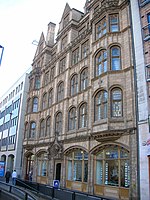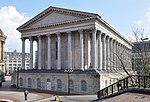Mason Science College
1875 establishments in EnglandBuildings and structures demolished in 1964Demolished buildings and structures in the West Midlands (county)Educational institutions established in 1875Science and technology in the West Midlands (county) ... and 1 more
University of Birmingham

Mason Science College was a university college in Birmingham, England, and a predecessor college of Birmingham University. Founded in 1875 by industrialist and philanthropist Sir Josiah Mason, the college was incorporated into the University of Birmingham in 1900. Two students of the college, Neville Chamberlain and Stanley Baldwin, later went on to become Prime Ministers of the UK.
Excerpt from the Wikipedia article Mason Science College (License: CC BY-SA 3.0, Authors, Images).Mason Science College
Centenary Way, Birmingham Ladywood
Geographical coordinates (GPS) Address Nearby Places Show on map
Geographical coordinates (GPS)
| Latitude | Longitude |
|---|---|
| N 52.48 ° | E -1.9051 ° |
Address
Centenary Way
Centenary Way
B3 3AX Birmingham, Ladywood
England, United Kingdom
Open on Google Maps









